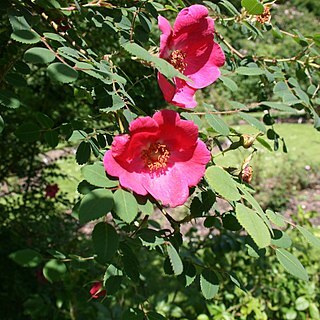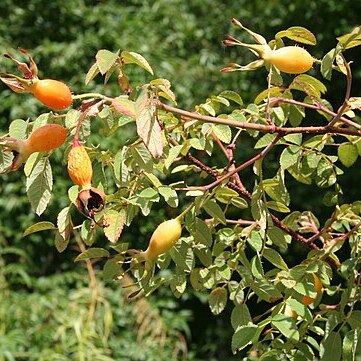Shrubs 1–4 m tall. Branchlets terete, glabrous or sparsely puberulous; prickles absent or if present, paired below leaves, straight or slightly curved, to 5 mm, stout, flat, tapering below to broad base. Leaves including petiole 7–13 cm; stipules broad, mostly adnate to petiole, free parts long ovate, glabrous, margin glandular serrate, apex acute; rachis and petiole puberulous, glandular-pubescent, sparsely small prickly, leaflets 7–13, ovate, elliptic, or oblong-ovate, 1–5 × 0.8–2.5 cm, abaxially densely pubescent or only along prominent veins pubescent, adaxially glabrous, base subrounded or broadly cuneate, margin acutely simply serrate, apex acute or rounded-obtuse. Flowers solitary, or 2 or 3 and fasciculate, 4–6 cm in diam.; pedicel 1–3 cm, usually densely stipitate glandular, rarely glabrous; bracts 1 or 2, oblong-ovate, to 2 cm, margin glandular-pubescent, apex acute or acuminate. Hypanthium ovoid. Sepals 5, ovate, leaflike, abaxially glabrous or with a few glandular bristles at base, adaxially pubescent, pinnately lobed. Petals 5, deep red, broadly obovate, base broadly cuneate, apex emarginate. Styles free, shorter than stamens, pubescent. Hip purple-red or orange-red, globose-ovoid, to 5 cm, 1–2 cm in diam., with a short neck at apex, stipitate glandular, with persistent, erect sepals. Fl. Jun–Jul; fr. Aug–Oct.
More
A shrub. It grows 3 m high. It spreads 3 m wide. It loses its leaves during the year. The stems are stout and erect. There are scattered thorns. The leaves are dark green. The flowers are single and red. The fruit are rose hips. They hang down and are rounded bottle shaped. They are orange-red.
The fruit are eaten raw. They are also preserved, pureed, and made into jams, syrups, soups etc. The dried fruit can be ground into a powder and added to drinks, waffles and pancakes.
Can be grown by cuttings or seedlings. Seeds needs scarification.


